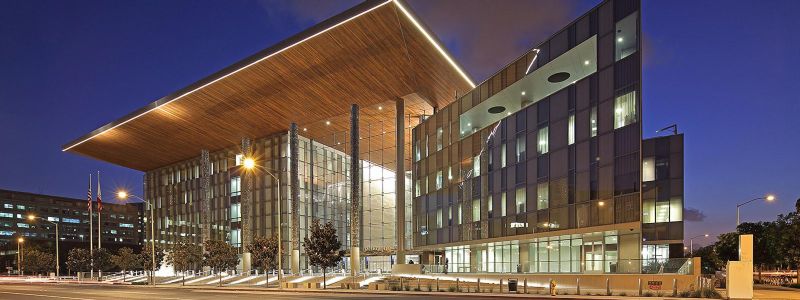
Featured Project Return to Projects List
Governor George Deukmejian Courthouse
Project Information
- Project Location:
- Long Beach, CA
- Approx Contract:
- $400,000,000
- Status:
- Completed - Jan 2013
- Structure Type:
- Court House
- LEED Certification (target):
-
 Gold
Gold
References
- Architect:
- AECOM
- Client:
- Judicial Council of California
Scope Of Work
Delivered through a unique public-private partnership agreement between Long Beach Judicial Partners LLC (LBJP) and the Judicial Council of California, the Governor George Deukmejian Courthouse is the first social infrastructure project in the United States procured under the principles of Performance-Based Infrastructure (PBI) contracting.
Completed in 2013, the 545,000 square-foot, five-story court building houses 31 courtrooms, as well as administration offices, Los Angeles lease space, and retail space. The facility includes below-grade secure inmate transfer facilities, detention facilities, and separate secure parking areas for judges. The striking public entrance boasts a five-level atrium enclosed on two ends by cable-supported glass walls. These glass walls are the largest system of this type in Southern California. Overhead, pedestrian bridges enable justice agency staff to move quickly to and from the courtrooms. Defendants in custody move through separate corridors from an underground holding .
Three restaurant concessionaire spaces are included as part of a 4,500 square-foot food court adjoining the main courthouse building. This dining facility is accessible from the street and opens to the surrounding downtown residential and business community. In addition, there is one convenience store space in the court building.
Clad in deeply-articulated curtain wall and stone elements, the courthouse spans two city blocks in downtown Long Beach and replaces a functionally-obsolete courthouse building one block away. In addition to the new court building, the team also renovated and expanded an existing parking structure.
There are over 20 different types of exterior glass in various panels ranging from typical clear vision glass to custom ceramic frit patterns using ballistic glazing. In addition to the glass, some of the units contain meticulously formed 'fluted' aluminum panel inserts that provide the illusion of depth through the casting of shadows on the glass.
Making sure that everything came together at the right time proved to be a challenge for Clark's project team – a challenge that they met head on. Each unit was planned from the beginning to fit in its place on the building like a jigsaw puzzle. This required meticulous coordination by the project team. In addition to a rigorous design review, several test samples and mock-ups were created to ensure that units were properly designed. The manufacturing process started while the design of the building was still being finalized. The process took place off-site factories where each panel was carefully formed and fabricated to specifications.
Construction Mock-Ups
Clark's team worked to anticipate the needs of the end-users, as well as address any constructability issues, by constructing two full-size mockups of a courtroom and adjacent detention areas.
in a rented warehouse building near the site, the first mockup was constructed for judges, court reporters, Los Angeles Sheriffs’ deputies, and other court personnel to act out courtroom procedures and scenarios.
During these sessions, these end-users provided critical feedback on the functionality of the mockup. The judge’s bench, witness box, courtroom clerk’s station, court reporter’s station, attorneys’ tables, spectator seating, and jury box were mocked-up by the project team utilizing plywood or actual furniture. Also included were ramps to confirm proper accessibility and projection screens for evidence presentations. Various bench height options were provided for the presiding judge in order to achieve the ideal heights and sightlines.
The second mockup featured all of the finish materials. Its construction, three months in the making, provided Clark with an understanding of the optimum installation sequence. It also helped the team identify any constructability concerns and challenging details.
“The project team did a wonderful job in designing and constructing a mock-up that allowed the judges and staff to truly test the performance of the future courtrooms.
− Clifford Ham, Principal Architect of the AOC
Performance-Based Infrastructure
The facility is the first social performance-based infrastructure (PBI) project in the United States. Under a turnkey public-private partnership, the cost and risk of the courthouse, including development, design, construction, operations, and maintenance, were transferred from the public sector to a private-sector team that included Clark and Edgemoor Infrastructure & Real Estate, among others.
The performance-based contract allowed the courthouse to be constructed without any public funding and provides for the ongoing maintenance and performance of the facility. Under the PBI agreement, the California Administrative Office of the Courts (AOC) will own the building and the Superior Court of Los Angeles will occupy the space. The AOC will pay an annual availability payment for 35 years. Under the terms of the agreement, the AOC can deduct a specific amount from the availability payment if components of the building do not work. For example, there is a $5,000 deduct for every two hours that certain elevators are inoperable.
Executing the project under the PBI model required a strong commitment to the schedule while balancing the demands of the price-certain contract with stakeholder input. By integrating the expertise of the private-sector team members in the development and design-build process, the group met the goals of the client, and the project, and delivered the courthouse 11 days ahead of schedule.
Proactive Planning Minimizes Impacts to the Community
One of the challenges Clark's team immediately faced was the presence of water transmission lines, gas transmission lines, storm and sanitary drain systems, power, telephone cable, and fiber optic lines that crossed the site in several locations. Each of these utilities had to be relocated outside the building property before construction could commence. This work had the potential to affect the surrounding community due to the possibility of utility interruptions, long-term lane closures, and other neighborhood inconveniences.
Recognizing this, the project team took an active role early in the process and coordinated the work to minimize impacts to the surrounding community. Within days of contract , the team was working with the City’s Department of Public Works (DPW), Long Beach Water Department, Long Beach Gas and Oil, and Southern California Edison to develop a plan of action to relocate the existing utilities so that construction could begin within a few months. This effort ensured that all approvals were in place prior to beginning work. The team met with those neighbors most affected and developed plans that included adjusting working hours to minimize noise and scheduling potentially disruptive activities outside of school hours for the Chavez Elementary School, which is across the street from the site.

